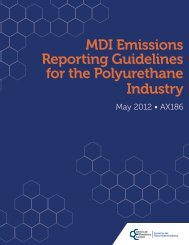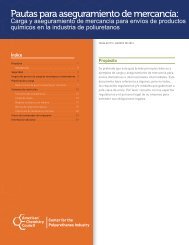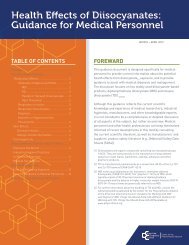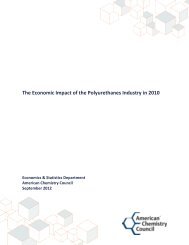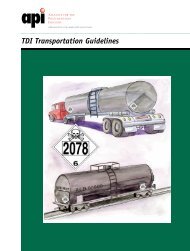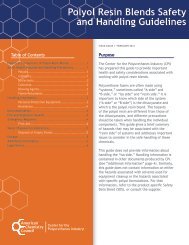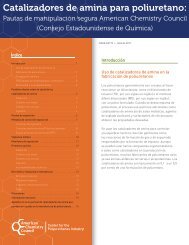MDI Emissions Reporting Guidelines for the ... - Polyurethanes
MDI Emissions Reporting Guidelines for the ... - Polyurethanes
MDI Emissions Reporting Guidelines for the ... - Polyurethanes
Create successful ePaper yourself
Turn your PDF publications into a flip-book with our unique Google optimized e-Paper software.
Use of TRI Database<br />
<strong>MDI</strong> <strong>Emissions</strong> <strong>Reporting</strong> <strong>Guidelines</strong> <strong>for</strong> <strong>the</strong> <strong>Polyurethanes</strong> Industry<br />
When Congress passed <strong>the</strong> EPCRA in 1986, EPA were mandated to promote contingency planning <strong>for</strong><br />
chemical releases and provide <strong>the</strong> public with previously unavailable in<strong>for</strong>mation about toxic and<br />
hazardous chemicals in <strong>the</strong>ir communities.<br />
Under Section 313(h) of EPCRA, Congress provides <strong>for</strong> <strong>the</strong> wide distribution of <strong>the</strong> industry<br />
in<strong>for</strong>mation ga<strong>the</strong>red. The release <strong>for</strong>ms required under this section are intended to provide<br />
in<strong>for</strong>mation to federal, state and local governments and <strong>the</strong> public. This includes citizens of<br />
communities surrounding <strong>the</strong> covered facilities. These <strong>for</strong>ms provide in<strong>for</strong>mation about chemical<br />
releases to <strong>the</strong> environment to enable government agencies, researchers, and o<strong>the</strong>r individuals<br />
conducting research and data ga<strong>the</strong>ring to develop appropriate regulations, guidelines, and<br />
standards. Since <strong>the</strong> TRI data has become available, it has become a useful resource <strong>for</strong> many<br />
different organizations:<br />
Federal, state and local governments use TRI data to set <strong>the</strong> priorities and allocate<br />
environmental protection resources.<br />
Regulators use TRI data to set permit limits, measure compliance with those limits, and<br />
target facilities <strong>for</strong> en<strong>for</strong>cement activities.<br />
Governments use TRI data to assess or modify taxes and fees based on toxic emissions or<br />
overall environmental per<strong>for</strong>mance.<br />
Communities use TRI data to begin dialogues with local facilities and to encourage <strong>the</strong>m to<br />
reduce <strong>the</strong>ir emissions, develop pollution prevention plans, and address safety measures.<br />
Industry uses TRI data to identify pollution prevention opportunities, set goals <strong>for</strong> toxic<br />
chemical release reductions, and demonstrate its commitment to and progress in reducing<br />
emissions.<br />
Public interest groups use TRI data to identify <strong>the</strong> potential need <strong>for</strong> new environmental<br />
regulations or improved implementation and en<strong>for</strong>cement of existing regulations.<br />
Consultants and o<strong>the</strong>rs use TRI data to identify business opportunities, such as marketing<br />
pollution prevention and control technologies to TRI reporting facilities.<br />
There<strong>for</strong>e, it is important that reports be as accurate as possible. Overestimating emissions can lead<br />
regulators and o<strong>the</strong>rs to seek imposition of controls that are not scientifically justified, while<br />
underestimating emissions can risk en<strong>for</strong>cement action by <strong>the</strong> Agency.<br />
1-2



